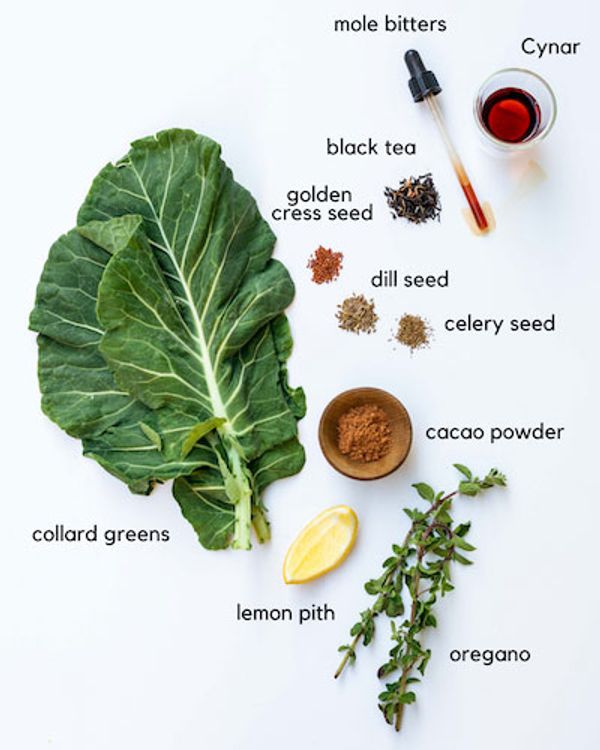Bitterness is a critical component of building intensity and complexity of flavor, but here in the U.S. we often shy away from using bitterness to accentuate our food and instead focus on tired adages like "fat is flavor" when attempting to build nuance into dishes. I'd like to divulge why bitterness is so key to developing complexity in finished foods, with a short guide on different ways you can play with the styles, levels and textures of the taste.
Why is bitterness an important part of flavor? To start, our taste buds are extremely attuned to the taste of bitterness, especially at the backs of our mouths. Scientists theorize this evolved as a "last chance" button of sorts to detect potentially poisonous foods and allow us to physically eject them from our bodies, as almost all toxic plants are bitter. This means that we don't need to use a lot of bitterness for most people to discern it on the plate — a little goes a long way and makes a big impact.
Also very interestingly, bitter is one of our five primary tastes (six if you count fat, seven if you count spice), and it balances out umami — similar to how sourness helps neutralize fattiness. You can increase umami and bitterness as you cook, knowing that as long as the two are in sync, the final product will taste balanced. In my experience, incorporating a bitter note is a big part of the "craveability" factor that many of us chefs are striving for when we cook.
Bitterness also helps cleanse our palates; in a way, it's like taking a whiff of coffee beans in between wines during a tasting. When I think back to the times I've tasted something very delicious but just can't stand more than a few bites before my taste buds are overwhelmed (e.g. most commonly when I eat truffles, wagyu or caviar), I find it's because there's just not enough bitterness present to make me want more. While it's not the flavor you want to blanket the food with, I liken it to little boosts of adrenaline for your taste buds to keep them stimulated while reformatting your palate back to neutral so the next food still feels interesting as we continue to eat. Maybe this is why naturally caffeinated items are bitter?
Bitterness also helps cleanse our palates; in a way, it's like taking a whiff of coffee beans in between wines during a tasting.
When cooking, think about when and how your bitter component is being incorporated, as that will likely determine when that same bitterness will spark your diner's taste receptors. Sprinkling a warm, rich, bitter ingredient like cacao powder on top to finish a dish versus braising meat in a juicy but tannic red wine for hours feels different because the ingredient's bitterness reaches our tongues in varying stages when eating. Also consider how that bitter ingredient is cut: Large strips of collards as a side yield different results than having thin chiffonades incorporated throughout a dish.
When eating, consider what hits your tongue first versus last. What flavors are present in each of these stages? Where the bitterness "sits" in a dish is a manifestation of how it independently smells and tastes, and when and how it was incorporated. Do you want subtle bitterness dispersed evenly throughout a soup or concentrated at the beginning or end of the eating experience? If you're creating a plated dish, is there bitterness in every component or accents like a few dots of a fluid gel?
 Bitter Ingredients (Courtesy of Jenny Dorsey)
Bitter Ingredients (Courtesy of Jenny Dorsey)
I've put together a short chart of bitter ingredients that you can experiment with. It is certainly not exhaustive but will hopefully help turn your attention to some interesting new components to play with the next time you cook. Why not use a whole lemon when braising to infuse some of that bitter pith into the foundation of that dish? What about spiking a classic vodka sauce with a touch of bitter liqueur instead? Perhaps black tea can be the secret ingredient of your next spice blend. Once you master the nuance of bitterness, you'll see the boundaries of deepening flavor profiles will expand exponentially.
By Chef Jenny Dorsey, Institute of Culinary Education
Read more
from the Institute of Culinary Education
- The secret to the best grilled ribs ever is your oven
- How to make ceviche at home, according to a professional chef
- A simple guide to buying and storing spices like a professional chef
- Match your salad to the winter season — the possibilities are quite endless
- Take homemade pasta to the next level with easy techniques that use simple ingredients




Shares